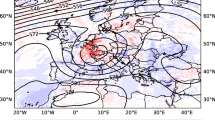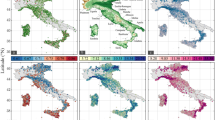Abstract
Twelve commonly used probability distributions are evaluated to identify the most suitable model that could provide accurate extreme rainfall estimates in Egypt. Three popular parameter estimation methods are applied: the method of moments, L-moments and maximum likelihood. The performance of the models is evaluated based on several numerical and graphical goodness-of-fit criteria. The proposed procedure is applied to annual maximum daily rainfall data from a network of 31 stations located in Egypt. The results indicate that no single distribution performed the best at all stations. Log-Normal, Log-Pearson Type III and Exponential are the top three distributions for the frequency analysis of daily annual extreme rainfalls in Egypt, i.e. they are selected as the “optimum” models for 23%, 19% and 19% of the total stations, respectively. In contrast, the distributions: Normal, Gumbel, Logistic and Generalized Logistic are not suitable for describing the extreme rainfalls in the country. The performances of both L-moments and maximum likelihood methods are almost equal and much better than that of the method of moments. Additionally, Depth-Duration-Frequency curves were established for 18 stations by using the “optimum” model, which can support the design of hydraulic structures. The findings from this study would be helpful for rainfall frequency analysis in similar arid countries.











Similar content being viewed by others
References
Acquah HG (2010) Comparison of Akaike information criterion (AIC) and Bayesian information criterion (BIC) in selection of an asymmetric price relationship. J Dev Agric Econ 2(1):1–6
Akaike H (1974) A new look at the statistical model identification. IEEE Trans Autom Control 19(6):716–723
Ball J, Babister M, Nathan R, Weeks W, Weinmann E, Retallick M, Testoni I (2016) Australian rainfall and runoff: a guide to flood estimation. Commonwealth of Australia
Beskow S, Caldeira TL, Millo CR, Faria LC, Guedes HAS (2015) Multiparameter probability distributions for heavy rainfall modeling in extreme southern Brazil. Journal of Hydrology: Regional Studies. Elsevier B.V., 4(PB), pp. 123–133. doi: https://doi.org/10.1016/j.ejrh.2015.06.007
Bonnin GM, Martin D, Lin B, Parzyok T, Yekta M, Riley D (2006) ‘Precipitation-frequency atlas of the United States, Volume 1, Version 4.0: Semiarid Southwest (Arizona, Southeast California, Nevada, New Mexico)’, NOAA Atlas 14
Burnham KP, Anderson DR (2002) Model selection and multimodel inference: a practical information-theoretic approach. Springer-Verlag New York, New York, USA
Burnham KP, Anderson DR (2004) Multimodel inference: understanding AIC and BIC in model selection. Sociol Methods Res 33:261–304
Busemeyer JR, Diederich A (2014) Chapter 4 - Estimation and testing of computational psychological models, in Neuroeconomics (Second Edition), pp. 49–61
Coles S (2001) An introduction to statistical modeling of extreme values. Springer, London
Cunnane C (1989) ‘Statistical distributions for flood frequency analysis’, Operational hydrological Report No. 5/33, World Meteorological Organization (WMO), Geneva, Switzerland
EEAA (2016) Egypt third national communication under the United Nations framework convention on climate change
El Kenawy A, López-Moreno JI, Vicente-Serrano SM, Morsi F (2010) Climatological modeling of monthly air temperature and precipitation in Egypt through GIS techniques. Clim Res 42:161–176. https://doi.org/10.3354/cr00871
Elmenoufy HM, Morsy M, Eid MM, El Ganzoury A, Wahab MMA (2017) Towards enhancing rainfall projection using bias correction method: case study Egypt. IJSRSET 6(3):187–194
Gado TA (2020). Statistical behavior of rainfall in Egypt. In: Negm A. (eds) Flash floods in Egypt. Advances in science, technology & innovation (IEREK Interdisciplinary Series for Sustainable Development). Springer, Cham. https://doi.org/10.1007/978-3-030-29635-3_2
Gado TA, El-Agha DE (2020) Feasibility of rainwater harvesting for sustainable water management in urban areas of Egypt. Environ Sci Pollut Res 27:32304–32317. https://doi.org/10.1007/s11356-019-06529-5
Gado TA, Nguyen VTV (2015) Comparison of homogenous region delineation approaches for regional flood frequency analysis at ungauged sites. J Hydrol Eng (ASCE), 21 (3), pp. 04015068-1: 04015068-10
Gado TA, Nguyen VTV (2016a) An at-site flood estimation method in the context of nonstationarity. I: A simulation study. J Hydrol Eng 535:710–721
Gado TA, Nguyen VTV (2016b) An at-site flood estimation method in the context of nonstationarity. II: Statistical analysis of floods in Quebec. J Hydrol Eng 535:722–736
Gado TA, Nguyen VTV (2016c) Regional estimation of floods for ungauged sites using partial duration series and scaling approach. J Hydrol Eng (ASCE) 21(12). https://doi.org/10.1061/(ASCE)HE.1943-5584.0001439
Gado TA, El-Hagrsy RM, Rashwan IMH (2019) Spatial and temporal rainfall changes in Egypt. Environ Sci Pollut Res 26:28228–28242. https://doi.org/10.1007/s11356-019-06039-4
Greenwood JA, Landwehr JM, Matalas NC, Wallis JR (1979) Probability weighted moments: definition and relation to parameters of several distributions expressed in inverse form. Water Resour Res 15(5):1049–1064
Griffis VW, Stedinger JR (2007) Evolution of flood frequency analysis with bulletin 17. J Hydrol Eng 12(3):283–297
Haddad K, Rahman A (2011) Selection of the best fit flood frequency distribution and parameter estimation procedure: a case study for Tasmania in Australia. Stoch Env Res Risk A 3:415–428. https://doi.org/10.1007/s00477-010-0412-1
Hershfield, D.M. (1962) Rainfall frequency atlas of the United States for durations from 30 minutes to 24 hours and return periods from 1 to 100 years. U.S. Weather Bureau Technical Paper 40, Washington, D.C
Hosking JRM (1986) The theory of probability weighted moments. Research Report RC12210, IBM Research Division, Yorktown Heights, N.Y
Hosking JRM (1990) L-moments: analysis and estimation of distributions using linear combinations of order statistics. Journal of the Royal Statistical Society Series 52(1):105–124
Kaźmierczak B, Kotowski A (2015) The suitability assessment of a generalized exponential distribution for the description of maximum precipitation amounts. J Hydrol 525:345–351. https://doi.org/10.1016/j.jhydrol.2015.03.063
Koutsoyiannis D, Kozonis D, Manetas A (1998) A mathematical framework for studying rainfall intensity-duration-frequency relationships. J Hydrol 206:118–135
Lang M, Bobe B (1999) Towards operational guidelines for over-threshold modeling. J Hydrol 225:103–117
Lee SH, Maeng SJ (2003) Frequency analysis of extreme rainfall using L-moment. Irrig Drain 230:219–230. https://doi.org/10.1002/ird.090
Mahdavi M, Osati K, Sadeghi SAN, Karimi B, Mobaraki J (2010) Determining suitable probability distribution models for annual precipitation data ( a case study of Mazandaran and Golestan Provinces ). Journal of Sustainable Development 3(1):159–168
Mamoon A, Rahman A (2016) Selection of the best fit probability distribution in rainfall frequency analysis for Qatar. Nat Hazards. Springer Netherlands 86(1):281–296. https://doi.org/10.1007/s11069-016-2687-0
Nashwan MS, Shahid S, Rahim NA (2018) Unidirectional trends in annual and seasonal climate and extremes in Egypt. Theor Appl Climatol 136:457–473. https://doi.org/10.1007/s00704-018-2498-1
Natural Research Council of Canada (1989) Hydrology of floods in Canada: a guide to planning and design. Ottawa, 245
Nguyen VTV, Mayabi A (1991) Probabilistic analysis of summer daily rainfall for the Montreal Region. Canadian Water Resources Journal 16(1):65–80. https://doi.org/10.4296/cwrj1601065
Nguyen TH, Outayek S, Lim SH, Nguyen VTV (2017) A systematic approach to selecting the best probability models for annual maximum rainfalls – a case study using data in Ontario (Canada). J Hydrol. Elsevier B.V. 553:49–58. https://doi.org/10.1016/j.jhydrol.2017.07.052
Ogunlela AO (2001) Stochastic analysis of rainfall events in Ilorin, Nigeria. Journal of Agricultural Research and Development 1:39–50
Olofintoye OO, Sule BF, Salami A (2013) Best–fit probability distribution model for peak daily rainfall of selected Cities in Nigeria. J Chem Inf Model 53(3):1689–1699. https://doi.org/10.1017/CBO9781107415324.004
Parida BP (1999) Modelling of Indian summer monsoon rainfall using a four-parameter Kappa distribution. Int J Climatol 19:1389–1398
Park JS, Jung HS (2002) Modelling Korean extreme rainfall using a Kappa distribution and maximum likelihood estimate. Theor Appl Climatol 72:55–64
Rahman AS, Rahman A, Zaman MA, Haddad K, Ahsan A, Imteaz M (2013) A study on selection of probability distributions for at-site flood frequency analysis in Australia. Nat Hazards 69:1803–1813. https://doi.org/10.1007/s11069-013-0775-y
Rao AR, Hamed KH (2000) Flood frequency analysis. CRC Press, Boca Raton, London, p 356
Salinas JL, Castellarin A, Kohnová S, Kjeldsen TR (2014) Regional parent flood frequency distributions in Europe – Part 2: Climate and scale controls. Hydrol Earth Syst Sci 18(11):4391–4401
Sen Z, Eljadid AG (1999) Rainfall distribution functions for Libya and rainfall prediction. Hydrol Sci J 4(5):665–680
Soro, G. E., Goula, T. A., Kouassi, F. W., and Srohourou, B. (2010) Update of intensity-duration-frequency curves for precipitation of short durations in tropical area of West Africa (Cote D’ivoire). Journal of applied sciences, pp. 704–715.
Tao DQ, Nguyen TV, Bourque A (2002) On selection of probability distributions for representing extreme precipitations in Southern Quebec. Annual Conference of the Canadian Society for Civil Engineering, pp. 1–8
Topaluglu F (2002) Determining suitable probability distribution models for flow and precipitation series of the Seyhan River Basin. Turk J Agric For 26:187–194
Vivekanandan N (2014) Rainfall frequency analysis using L-moments of probability distributions. International Journal of Computer Application and Engineering Technology 3(3):248–256
Wdowikowski M, Kaźmierczak B, Ledvinka O (2016) Maximum daily rainfall analysis at selected meteorological stations in the upper Lusatian Neisse River basin. Meteorology Hydrology and Water Management 4(1):53–63. https://doi.org/10.26491/mhwm/63361
Wdowikowski M, Kotowski A, Dabek PB, Kazmierczak B (2017) Probabilistic approach of the Upper and Middle Odra basin daily rainfall modeling. E3S Web of Conferences 17, 00096, doi: https://doi.org/10.1051/e3sconf/20171700096.
Zalina MD, Desa MN, Nguyen VTV, Kassim AHM (2002) Selecting a probability distribution for extreme rainfall series in Malaysia. Water Sci Technol 45(2):63–68
Availability of data and material
On behalf of all authors, the corresponding author states that all data and materials as well as software application support their published claims and comply with field standards.
Author information
Authors and Affiliations
Contributions
Conceptualization, Tamer A. Gado and Bakenaz A. Zeidan; methodology, Abeer M. Salama and Tamer A. Gado; writing—original draft preparation, Abeer M. Salama; writing—review and editing, Tamer A. Gado and Bakenaz A. Zeidan. All authors have read and agreed to the published version of the manuscript.
Corresponding author
Ethics declarations
Ethics approval
Not applicable.
Consent to participate
Not applicable.
Consent for publication
Not applicable.
Conflict of interest
The authors declare no competing interests.
Additional information
Publisher’s note
Springer Nature remains neutral with regard to jurisdictional claims in published maps and institutional affiliations.
Rights and permissions
About this article
Cite this article
Gado, T.A., Salama, A.M. & Zeidan, B.A. Selection of the best probability models for daily annual maximum rainfalls in Egypt. Theor Appl Climatol 144, 1267–1284 (2021). https://doi.org/10.1007/s00704-021-03594-0
Received:
Accepted:
Published:
Issue Date:
DOI: https://doi.org/10.1007/s00704-021-03594-0




